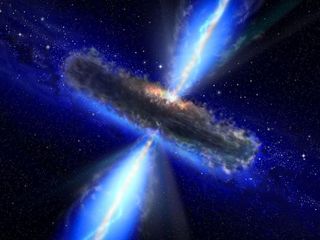Stephen Hawking’s black hole radiation paradox could finally be solved — if black holes aren’t what they seem

A new study suggests that black holes may not be the featureless, structureless entities that Einstein’s general theory of relativity predicts them to be. Instead, the cosmic monsters might be bizarre quantum objects known as “frozen stars.”
While these would share some similarities with black holes, the hypothetical celestial bodies differ in crucial ways that could potentially resolve the infamous Hawking radiation paradox (named for the late physicist Stephen Hawking, who proposed the phenomenon). This paradox arises because the theoretical radiation emitted by a black hole’s event horizon seemingly carries no information about the matter that formed the black hole, which contradicts a fundamental principle of quantum mechanics stating that information cannot be destroyed.
Moreover, unlike the conventional black holes, frozen stars are not expected to harbor a singularity — a point of infinite density at their centers — which resolves another contradiction between the classical picture of black holes and the general rule in physics that infinities cannot exist in nature. When infinities do appear in a theory, it usually signals the theory’s limitations.
“Frozen stars are a type of black hole mimickers: ultracompact, astrophysical objects that are free of singularities, lack a horizon, but yet can mimic all of the observable properties of black holes,” Ramy Brustein, a professor of physics at Ben-Gurion University in Israel, told Live Science in an email. “If they actually exist, they would indicate the need to modify in a significant and fundamental way Einstein’s theory of general relativity.”
Brustein is the lead author of a study describing the frozen star theory, published in July in the journal Physical Review D.
Resolving the paradox
The classical model of a black hole, first described by Karl Schwarzschild in 1916, portrays black holes as having two key features: a singularity where all the mass is concentrated and an event horizon, a boundary from which nothing, not even light, can escape.
However, this model encounters a serious problem when quantum mechanics is introduced. In the 1970s, Stephen Hawking famously discovered that quantum effects near the event horizon should lead to the creation of particles out of the vacuum of space, a process known as Hawking radiation. This radiation would cause the black hole to gradually lose mass and eventually evaporate completely.
Related: ‘Twisty’ new theory of gravity says information can escape black holes after all
The paradox arises because this radiation appears to carry no information about the matter that originally formed the black hole. If the black hole evaporates completely, this information seems to be lost forever, violating the principles of quantum mechanics, which dictate that information must be conserved. This contradiction is known as the information loss paradox, and it has been one of the most significant challenges in theoretical physics.
In their new study, Brustein and his co-authors A.J.M. Medved of Rhodes University and Tamar Simhon of Ben-Gurion University performed a detailed theoretical analysis of the frozen stars model, and found that it resolves the paradoxes of the traditional model because it lacks both a horizon and a singularity.
The authors found that if black holes are actually very compact objects composed of ultra rigid matter whose properties are inspired by string theory, the leading candidate for the theory of quantum gravity, they don’t collapse into infinitely dense points, and have a size slightly larger than the conventional event horizon, preventing the latter from forming.
“We have shown how frozen stars behave as (nearly) perfect absorbers although lacking a horizon and act as a source of gravitational waves,” said Brustein, noting that these objects can absorb almost everything that falls onto them, much like black holes. “Moreover, they source the same external geometry as that of a conventional model of black holes and reproduce their conventional thermodynamic properties.”

Testing the frozen star hypothesis
While the frozen star model presents a potential solution to the paradoxes associated with traditional black holes, scientists still need to test it experimentally.
But unlike conventional black holes, frozen stars are expected to have an internal structure, albeit one with bizarre properties dictated by quantum gravity. This paves the way to observationally discriminate between the two. The evidence could be present in gravitational waves — ripples in the fabric of space-time — generated during black hole mergers.
“This is when the distinctions would be most pronounced,” explained Brustein.
The team still needs to work out exactly what the internal structure of a frozen star would look like, and how it would differ from other extreme cosmic objects like neutron stars, but it’s achievable, Brustein said. From there, they could analyze data from existing and future gravitational wave observatories, because the gravitational waves emitted during the mergers are extremely powerful and can carry information about these ultracompact objects’ structure.
“A discovery of any of the predictions of the frozen star model will have a revolutionary impact,” Brustein said.
 Print
Print




